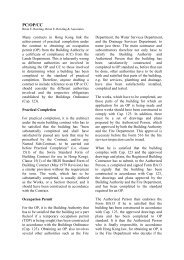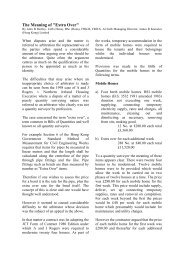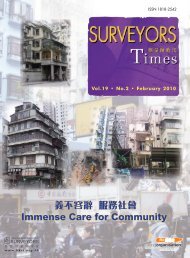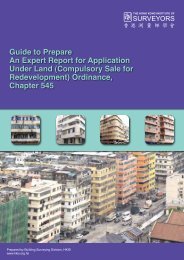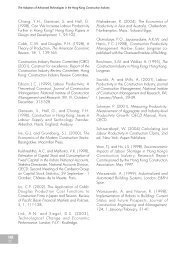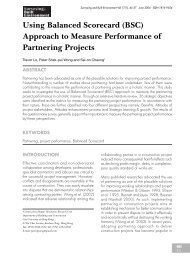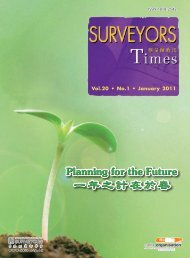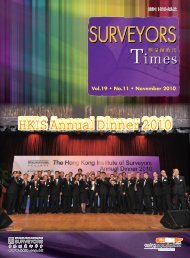Special issue to commemorate the 70th Anniversary of the Battle of ...
Special issue to commemorate the 70th Anniversary of the Battle of ...
Special issue to commemorate the 70th Anniversary of the Battle of ...
Create successful ePaper yourself
Turn your PDF publications into a flip-book with our unique Google optimized e-Paper software.
Decoding <strong>the</strong> Enigma <strong>of</strong> <strong>the</strong> Fall <strong>of</strong> <strong>the</strong> Shing Mun Redoubt Using Line <strong>of</strong> Sight Analysis<br />
Figure 3 shows <strong>the</strong> selected vertical pr<strong>of</strong>iles <strong>of</strong> <strong>the</strong><br />
Shing Mun Redoubt from PB 401b <strong>to</strong> PB 403 – a <strong>to</strong>tal<br />
ground distance <strong>of</strong> 494 metres. To move from one<br />
place <strong>to</strong> ano<strong>the</strong>r, a person must go up and down steps<br />
here and <strong>the</strong>re inside zig-zagging tunnels <strong>of</strong> varying<br />
heights and widths, and with ro<strong>of</strong>s punctuated by<br />
vertical air ducts and floors punctuated by rainwater<br />
basins that could have also served as grenade traps. We<br />
may infer that chasing and shooting inside <strong>the</strong> tunnel<br />
system with “long arms” (such as rifles and MMGs)<br />
was difficult and even hazardous. This supports <strong>the</strong><br />
Japanese account that <strong>the</strong>y did not shoot much, if at<br />
all. 11<br />
Shooting had <strong>to</strong> be confined <strong>to</strong> areas outside<br />
<strong>the</strong> tunnels. The dropping <strong>of</strong> grenades down air ducts<br />
along tunnels was possible, but this might kill both<br />
friends and enemies that were already fighting inside 12 .<br />
Figure 4 shows <strong>the</strong> vertical pr<strong>of</strong>iles <strong>of</strong> <strong>the</strong> Command<br />
Centre (Artillery Observation Post) <strong>of</strong> <strong>the</strong> Shing Mun<br />
Redoubt and <strong>the</strong> kitchen below. As explained above,<br />
we believe that Sergeant Mochizuki invaded <strong>the</strong> OP<br />
from <strong>the</strong> trench T3 outside <strong>the</strong> kitchen, which had two<br />
crucibles with s<strong>to</strong>ves and water tanks.<br />
Table 2 and Figure 5 address <strong>the</strong> questions <strong>of</strong> mutual<br />
fire support by <strong>the</strong> defensive structures <strong>of</strong> <strong>the</strong> Redoubt.<br />
Table 2 shows <strong>the</strong> lines <strong>of</strong> sight from any one PB<br />
or trench vis-à-vis all o<strong>the</strong>r PBs and trenches. Each<br />
defensive post was guarded by at least one o<strong>the</strong>r post as<br />
long as <strong>the</strong> o<strong>the</strong>r post was manned. Figure 5 shows <strong>the</strong><br />
beaten zones <strong>of</strong> <strong>the</strong> PBs, OP, and trenches derived from<br />
<strong>the</strong> assumptions and methods mentioned. The key facts<br />
established are that <strong>the</strong> entire access road along Jubilee<br />
Dam and its landings along <strong>the</strong> slopes <strong>of</strong> Needle Hill<br />
were under <strong>the</strong> direct fire cover <strong>of</strong> PB 402, and that <strong>the</strong><br />
slopes on <strong>the</strong> Needle Hill side <strong>of</strong> <strong>the</strong> Shing Mun River<br />
Valley were covered by PB401b. The key findings<br />
based on Figures 2 and 3 are:<br />
(1) The Royal Scots’ depiction <strong>of</strong> <strong>the</strong> OP as being<br />
separated from <strong>the</strong> rest <strong>of</strong> <strong>the</strong> Redoubt in terms<br />
<strong>of</strong> tunnel connection was correct: <strong>the</strong>re was a gap<br />
between Charing Cross and Shaftsbury Avenue<br />
(Figure 2).<br />
(2) The Artillery OP/Command Centre <strong>of</strong> <strong>the</strong><br />
Redoubt has more than one exit: T3 was <strong>the</strong><br />
nearest and Charing Cross <strong>the</strong> far<strong>the</strong>r alternative<br />
exit <strong>to</strong> <strong>the</strong> 3 hatches. (Figures 2 and 3).<br />
(3) The concrete tunnels inside <strong>the</strong> Redoubt varied<br />
by height and width and included vertical air<br />
ducts and rainwater/grenade traps (Figures 2 and<br />
3).<br />
We may infer from (3) that <strong>the</strong> built form prevented<br />
<strong>the</strong> enemy from easily shooting or undertaking a fast<br />
pursuit during <strong>the</strong> battle, as lines <strong>of</strong> sight were near<br />
zero and a person could easily stumble or collide with<br />
something in <strong>the</strong> darkness.<br />
11<br />
A lot <strong>of</strong> night attacks used <strong>to</strong> be made with grenades and edged weapons because that way one reduces <strong>the</strong> likelihood <strong>of</strong> ‘friendly fire’ casualties,<br />
especially at close quarters. One also ensures that, without muzzle flashes, <strong>the</strong> enemy is not sure <strong>of</strong> <strong>the</strong> location <strong>of</strong> an attacker.<br />
12<br />
Evidence <strong>of</strong> explosions <strong>of</strong> grenades, all dropped from <strong>the</strong> east through air vents along tunnels, can be found in a few places along Oxford Street<br />
(north <strong>of</strong> T4 and near T9) o<strong>the</strong>r than within <strong>the</strong> OP.<br />
SBE<br />
38




